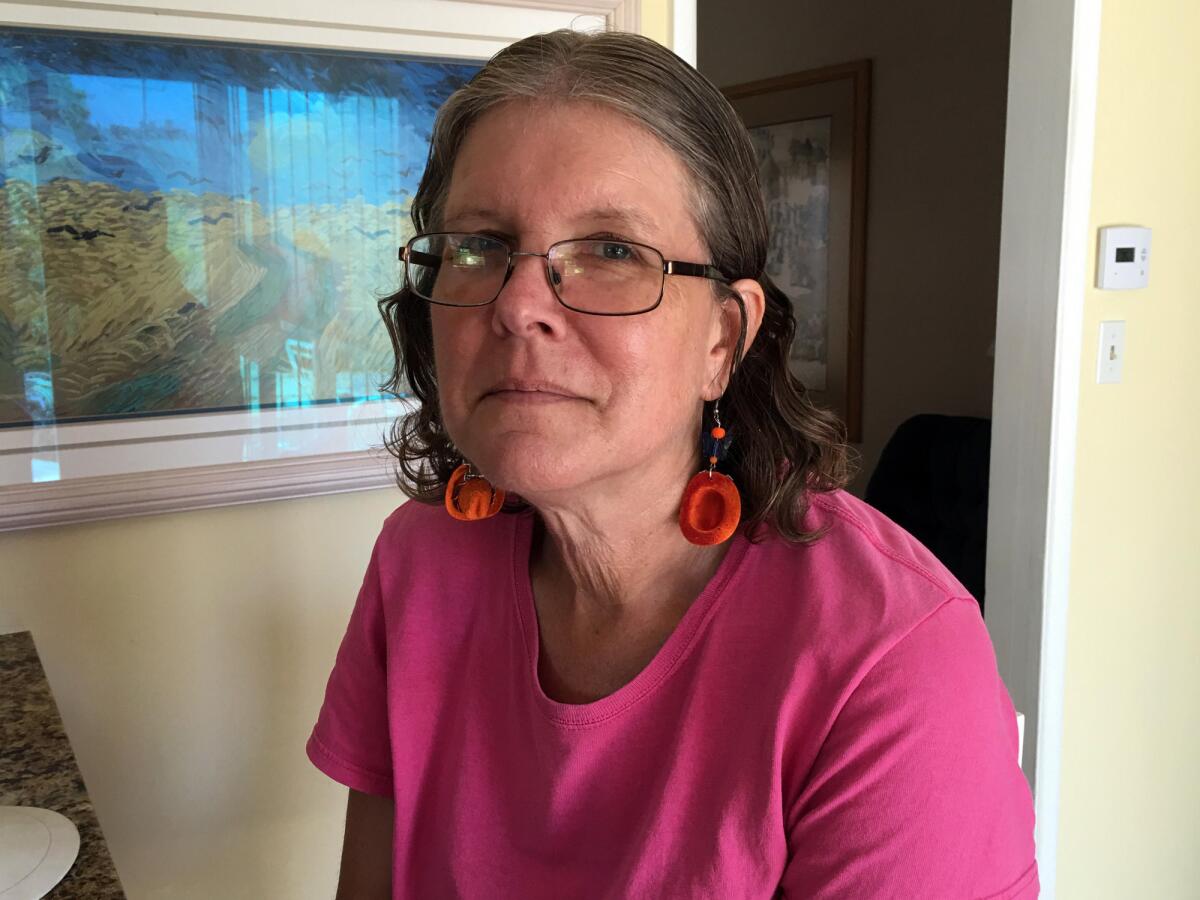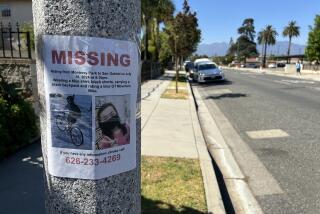Column: She vanished 18 months ago with no leads. Now, a volunteer cop has a troubling theory about what happened to her

- Share via
Last spring, an off-duty LAPD cop named Mike Goldberg went to the movies at the Laemmle in North Hollywood with his wife.
At the theater, he spotted a flier for a missing 57-year-old Manhattan Beach woman named Nancy Paulikas, who suffered from advanced Alzheimer’s disease and had vanished on Oct. 15, 2016, in Mid-City Los Angeles.
“I’ve been happily married to my wife of 25 years and I couldn’t imagine this happening,” said Goldberg, a patrol sergeant who has worked as a detective. “If you’re really a cop, real cops care.”
So Goldberg called Paulikas’ husband, Kirk Moody, and offered to assist in the search during his off-duty hours.
“It was kind of amazing,” said Joan Paulikas, Nancy’s mother.
“A lot of people volunteer for a lot of different causes, but for someone with a busy policeman’s life to say he wants to help, that’s special,” said George Paulikas, Nancy’s father.
Without a trace
In no time, Goldberg and Moody were visiting hospitals together, making calls, chasing leads and narrowing a list of several theories on what might have happened to Nancy Paulikas, a UCLA grad and computer engineer.
She and Moody, who met while working at TRW/Northrop Grumman, had retired early to pursue their love of hiking and other outdoor adventures. But Paulikas developed Alzheimer’s and it rapidly consumed her, to the point that she became unfamiliar with the story of her own life. Moody became her 24-hour caretaker as she retreated into a haze.
Before Goldberg came on the scene, Moody and his wife’s parents — joined by a small army of volunteers — had canvassed the city for months, distributing fliers and checking in with authorities. They got a lot of help from the Los Angeles and Manhattan Beach police departments and held out hope that she’d turn up soon.
When I first wrote about the case, in 2016, a reader reported a possible sighting that looked promising. It was in the vicinity of the Los Angeles County Museum of Art, where Moody and Paulikas got separated when he went to the restroom, and surveillance video from the neighborhood showed Paulikas strolling along a nearby street just after her disappearance.
Moody tracked it down and came up empty, as he has so many times. In the months since his wife’s disappearance, he has considered all the possibilities.
Maybe she died or was killed, but there was no coroner record of a woman matching her description. Maybe she’d been taken in by a good Samaritan, or became homeless, or had somehow left the state, although she was entirely unable to care for her own basic needs.
Homeless? Dead? Something else?
Those theories were plausible but not likely in the opinion of Goldberg, who educated himself by touching base with the missing persons unit of the LAPD and with Det. Mike Rosenberger of the Manhattan Beach Police Department, which is the official investigating agency.
Goldberg also went to training seminars and spoke to state missing persons specialists. And he had a piece of experience that was particularly useful:
Before becoming a cop, Goldberg — a former U.S. Army paratrooper with graduate degrees in socio-cultural anthropology and organizational leadership — worked in medical billing. So he had navigated the maze of reimbursement vagaries for the cost of caretaking, and that knowledge was a useful tool in trying to track Paulikas.
The more Goldberg learned about missing persons investigations, the more he became convinced that the most likely of the working theories is that Paulikas is alive and living in an elderly or assisted care facility somewhere in California.
A new theory
He’s not certain, of course, but his hypothetical begins like this:
Someone may have spotted Paulikas on the street, disoriented or in distress, after her disappearance. She might have been transported by emergency responders to a hospital that realized there’d be no way to get reimbursed for Paulikas’ care.
So she could have been shipped to a care facility or a homeless shelter, not necessarily with her best interests in mind.
“You’ve heard of patient dumping,” said Goldberg.
If she ended up in a licensed or unlicensed care facility, large or small, the caretaker may not have known who Paulikas was, despite statewide missing persons alerts that noted her description and severe Alzheimer’s.
Or something more nefarious may have happened.
A caretaker may have recognized Paulikas but kept her identity secret, because she was a source of steady income. Monthly reimbursements for care are available through Medi-Cal for Jane Does.
Or, in an even darker scenario, maybe a care facility had a female client — let’s call her Betty, says Goldberg — who died. Then along came Nancy, and to keep the money flowing without a hitch, the caretaker did a shuffle, and Nancy became Betty.
“If you have a death by natural causes, and you have a doctor willing to sign for her death certificate, she’ll go straight to release by a coroner without a record,” said Goldberg.
It’s a creepy possibility, but probably not all that far-fetched. Medical fraud is a fact of life, and in a rapidly aging population of boomers, it’s safe to assume that all manner of profiteering is in play.
Last year I visited a developmentally disabled woman living in half of a converted garage, for her entire Social Security check of nearly $900 a month. And she was one of nine residents in the unlicensed home on a normal residential street in the Valley. When I tried to find out how many such homes exist, no one at the city, county or state level had any idea.
“Follow the money,” George Paulikas said, describing the current strategy in the search for his daughter.
But in trying to do so, Paulikas and the rest of the team have been repeatedly frustrated by bureaucracy. It seemed to Moody and his cohorts that a database search of Medi-Cal reimbursements to care facilities for women with Alzheimer’s might shake loose a lead or two. But Moody says that after initial cooperation from the state Department of Health Care Services, repeated requests for a more extensive search have been rebuffed.
A state spokesman told me his department had already done what it could legally do, given patient privacy laws.
Moody disputes that, and said elected officials have backed his request for more information, also to no avail. Goldberg told me California’s missing persons guru, at the state attorney general’s office, expressed her own frustration about the difficulty of getting information out of Health Care Services, and told Goldberg this sort of thing “happens all the time.”
Flaws in the system
If there are holes in the system, or a lack of communication between agencies, someone needs to lead the way on fixes. L.A. County’s Bringing Our Loved Ones Home Task Force (wdacs.lacounty.gov/boloh) is a good start, and it was begun partly in response to Paulikas’ disappearance.
Also, family members have to make sure afflicted loved ones have identification bracelets or other ID with them at all times. The Alzheimer’s Assn. reports that 60% of those with dementia will wander, and if not found in 24 hours, up to half will suffer injury or death.
Goldberg said a database search for women between the ages of 47 and 67 with Alzheimer’s, whose care is covered by Medi-Cal, could turn up a couple thousand possibilities. That would make for a lot of pavement pounding, but Moody, Goldberg and the rest of the team say they’re prepared to chase every lead.
A $30,000 reward is available for information that brings Nancy Paulikas home.
Anyone with information on her whereabouts can call Manhattan Beach detectives at (310) 802-5120 or send an email to Moody at nancyismissing@gmail.com.
To read this article in Spanish, click here
Get more of Steve Lopez’s work and follow him on Twitter @LATstevelopez
More to Read
Sign up for Essential California
The most important California stories and recommendations in your inbox every morning.
You may occasionally receive promotional content from the Los Angeles Times.














